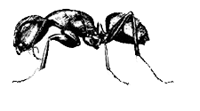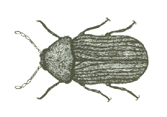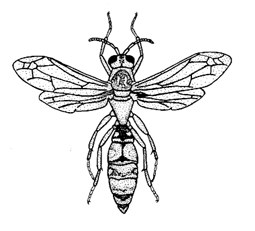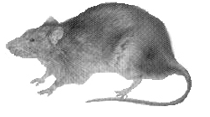Ants
 More than 12,500 species are classified with upper estimates of about 22,000 species. They are easily identified by their elbowed antennae and a distinctive node-like structure that forms a slender waist.
More than 12,500 species are classified with upper estimates of about 22,000 species. They are easily identified by their elbowed antennae and a distinctive node-like structure that forms a slender waist.
Ants have colonized almost every landmass on Earth. The only places lacking indigenous ants are Antarctica and certain remote or inhospitable islands. Ants thrive in most ecosystems, and may form 15 - 25 % of the terrestrial animal biomass. Their success has been attributed to their social organization and their ability to modify habitats, tap resources, and defend themselves. Their long co-evolution with other species has led to mimetic, commensal, parasitic, and mutualistic relationships.
Acrobat Ant ~ Carpenter Ant ~ Black Field Ant
Little Black Ant ~ Odorous House Ant ~ Pavement Ant
Beetles
 There are more than 800,000 species of insects on earth, more than all the other plants and animals combined. Of this great number of insects, nearly half are beetles. Unlike other insects, beetles have a pair of leathery protective wings called elytra that cover their membranous flight wings. During flight, the elytra are spread apart and the two flight wings are unfolded and extended. Beetles come in a variety of shapes and colors, from red "ladybugs" and metallic green fig beetles to lightning beetles that glow in the dark and huge horned beetles resembling a miniature rhinoceros. Colorful beetles are used for jewelry and pins, and shiny tropical scarab beetles are strung together to make unusual necklaces. Beetles range in size from less than a millimeter (1/100 of an inch) to tropical giants over six inches long. The largest giants may weigh 40 million times more than their lilliputian relatives.
There are more than 800,000 species of insects on earth, more than all the other plants and animals combined. Of this great number of insects, nearly half are beetles. Unlike other insects, beetles have a pair of leathery protective wings called elytra that cover their membranous flight wings. During flight, the elytra are spread apart and the two flight wings are unfolded and extended. Beetles come in a variety of shapes and colors, from red "ladybugs" and metallic green fig beetles to lightning beetles that glow in the dark and huge horned beetles resembling a miniature rhinoceros. Colorful beetles are used for jewelry and pins, and shiny tropical scarab beetles are strung together to make unusual necklaces. Beetles range in size from less than a millimeter (1/100 of an inch) to tropical giants over six inches long. The largest giants may weigh 40 million times more than their lilliputian relatives.
Anobiid Beetle ~ Cigarette Beetle ~ Black Carpet Beetle ~ Brown Spider Beetle
Drugstore Beetle
~ Granary Weevil ~ Larder Beetle ~ Sawtoothed Grain Beetle
Seed Beetle
Bees and Wasps
 Several wasps are social insects that produce a colony. Colonies begin anew each spring, initiated by a single fertilized female (queen) that has survived winter. The social wasps construct their nest of paper, which they produce by chewing on wood, scraps of paper and cardboard.
Several wasps are social insects that produce a colony. Colonies begin anew each spring, initiated by a single fertilized female (queen) that has survived winter. The social wasps construct their nest of paper, which they produce by chewing on wood, scraps of paper and cardboard.
Social wasp colonies are very small early in the season, but expand rapidly through the summer as more wasps are raised that assist in colony development. By the end of summer, a colony may include dozens, or even several hundred, individuals. Some wasps reared at the end of the season are fertile females (potential queens) and a few males. In fall, colonies are abandoned, never to be reused, and the fertilized females scatter to find protection during winter. The remaining members of the colony perish with cold weather.
Most social wasps rear their young on a diet of live insects. Several types of social wasps are important in controlling insect pests such as caterpillars. An exception to this is the western yellowjacket, which primarily scavenges dead insects, earthworms and other carrion, including garbage. This scavenging habit is usually why yellowjackets become serious nuisance problems. Male wasps occasionally visit flowers to feed on nectar; however, social wasps are generally not important plant pollinators.
Social Wasp ~ Bumble Bee
Rodents
 The single largest group of mammals is the Rodentia. Most non-flying mammals are rodents: there are about 1,500 living rodent species (out of about 4,000 living mammals overall). Most people are familiar with mice, rats, hamsters, and guinea pigs, which are commonly kept as pets. The Rodentia also includes beavers, muskrats, porcupines, woodchucks, chipmunks, squirrels, prairie dogs, marmots, chinchillas, voles, lemmings, and many others. (Incidentally, the Rodentia does not include rabbits; rabbits differ from rodents in having an extra pair of incisors and in other skeletal features. Rabbits, hares, and a few other species make up the Lagomorpha. Shrews, moles and hedgehogs are also not rodents; they are classified in the Insectivora.)
The single largest group of mammals is the Rodentia. Most non-flying mammals are rodents: there are about 1,500 living rodent species (out of about 4,000 living mammals overall). Most people are familiar with mice, rats, hamsters, and guinea pigs, which are commonly kept as pets. The Rodentia also includes beavers, muskrats, porcupines, woodchucks, chipmunks, squirrels, prairie dogs, marmots, chinchillas, voles, lemmings, and many others. (Incidentally, the Rodentia does not include rabbits; rabbits differ from rodents in having an extra pair of incisors and in other skeletal features. Rabbits, hares, and a few other species make up the Lagomorpha. Shrews, moles and hedgehogs are also not rodents; they are classified in the Insectivora.)
Field Mice ~ Rat ~ Squirrels
Other Common Pests
 Contained in the following pages are various pest including potentially harmful pests as well as those that are merely nuisances.
Contained in the following pages are various pest including potentially harmful pests as well as those that are merely nuisances.
Depending on the particular pest involved and the severity of the problem, non-chemical control methods may be the optimum solution.
Please feel free to contact us for more information.
207-582-0100
1-866-884-7378
Bed Bugs ~
Bird Mites ~
Boxelder Bugs ~
Clover Mites ~
Cluster Flies ~
Cockroaches
Earwigs ~
Fleas ~
Indian Meal Moth ~
Meal Worms ~
Silverfish ~
Spiders
Webbing Clothes Moth

